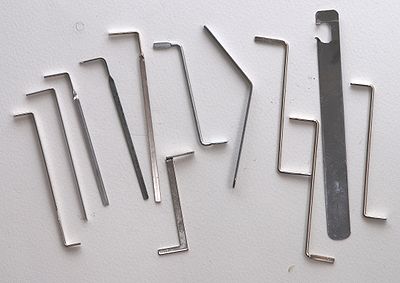Tension
Tension

Tension (or torque, torsion) is a fundamental lockpicking principle that allows a lock to be compromised by exploiting tolerance errors and binding to defeat each locking component individually. A tool is used to apply tension to the lock while a pick properly position internal components. Once all components are positioned correctly the tension tool may be used to actuate the locking bolt.
Tension tools are commonly referred to as tension bars, tension wrenches, or torque wrenches. Their design varies widely, but is most commonly associated with the L shaped pin-tumbler tension tool. Like picking tools, most tension tools leave forensic evidence in the lock.
Pin-tumbler/Wafer Tension Tools
In pin-tumbler, wafer, dimple, and axial locks, tension is applied to the plug of the lock by inserting the tension tool into the keyway.
The most common tension tools are L shaped or flat (Z/S shaped). Curves, serrations, and other modifications to the tip of the tool help to prevent slippage and enhance feedback.
Hands-free Tools
Hands-free tools attach themselves to the lock, but are not as popular because they provide little to no feedback.
- Weighted wrench, a normal L/flat wrench with a weight attached.
- Circular wrench, circular tool attached to the face of the lock with a dial to vary tension amounts.
Misc. Tools
- Y/pronged wrench, double sided wrench that grips both sides of the keyway. Popular when working with automobile locks.
- Falle tension wrench, a double sided wrench that grips the top and bottom of the keyway. Provides strong control over tension, and is useful for defeating security pins.
- "Tulip" wrench, staggered L shape tension wrench used on tulip style doorknobs.
- "Diamond" wrench, an elongated tension tool with a half-diamond tip. Used to provide tension in the center or back of the lock, at the bottom of the keyway.
Lever Tension Tools
In lever locks, a tension tool is inserted through the keyway and tension is applied directly to the bolt. In most cases, tension tools resemble the tip of a lever key.
Disc-detainer Tension Tools
In disc-detainer locks, tension is applied to varying discs in the lock, depending on the specifics of the lock. Locks are categorized as being top (front), bottom (back), or middle tensioned. In a bottom tensioned lock, tension is applied to the disc at the back of the lock.